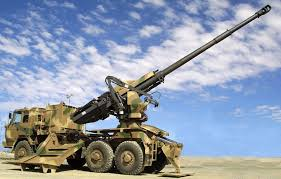Military Weapons: Evolution and Impact
Military Weapons: Evolution and Impact
Military weapons have been a cornerstone of human civilization, shaping the course of history through their ability to empower nations and transform conflicts. From primitive tools to advanced technological marvels, the evolution of military weaponry reflects humanity's ingenuity, resilience, and capacity for innovation. In this article, we explore the development, types, and implications of military weapons in modern times, focusing on their role in 21st-century warfare.
A Historical Perspective
Understanding military weapons requires a brief look at their historical progression. Early humans used stones, spears, and bows to hunt and defend themselves. The Bronze and Iron Ages saw the introduction of metal-based weapons, including swords and shields, which revolutionized combat. The advent of gunpowder in the 9th century led to firearms, cannons, and artillery, fundamentally altering warfare's dynamics.
By the 20th century, technological advances such as tanks, aircraft, and automatic weapons transformed conflicts into mechanized engagements. The introduction of nuclear weapons during World War II marked a new era, emphasizing deterrence and the potential for mass destruction.
Categories of Modern Military Weapons
Military weapons in the 21st century can be broadly categorized into the following:
1. Small Arms and Light Weapons (SALW)
Small arms and light weapons include firearms such as pistols, rifles, submachine guns, and light machine guns. These are typically used by individual soldiers or small groups. Advances in materials, optics, and design have made modern small arms more accurate, durable, and lethal.
Examples:
- M4 Carbine: A versatile rifle used by the U.S. military, offering semi-automatic and automatic fire modes.
- AK-47: Known for its reliability and widespread use.
2. Armored Vehicles
Armored vehicles provide mobility, protection, and firepower on the battlefield. These include tanks, infantry fighting vehicles (IFVs), and armored personnel carriers (APCs).
Examples:
- M1 Abrams: A main battle tank renowned for its firepower and advanced armor.
- BMP-3: A Russian IFV equipped with a powerful cannon and missile system.
3. Artillery Systems
Artillery plays a critical role in providing indirect fire support. Modern systems include self-propelled howitzers, multiple launch rocket systems (MLRS), and precision-guided munitions.
Examples:
- M777 Howitzer: A lightweight artillery piece used by various militaries.
- HIMARS: A mobile rocket system capable of delivering precision strikes.
4. Naval Weapons
Naval weapons encompass systems used on warships and submarines, including missiles, torpedoes, and naval guns.
Examples:
- Tomahawk Cruise Missile: A long-range missile used for land-attack missions.
- Mark 48 Torpedo: A heavyweight torpedo designed for submarines.
5. Aerial Weapons
Airpower has become a dominant force in modern warfare, with weapons ranging from air-to-air missiles to strategic bombers and drones.
Examples:
- F-35 Lightning II: A multirole stealth fighter equipped with advanced weaponry.
- MQ-9 Reaper: An unmanned aerial vehicle (UAV) used for reconnaissance and precision strikes.
6. Missiles and Rockets
Missile technology has advanced significantly, with capabilities including precision guidance, long-range strikes, and hypersonic speeds.
Examples:
- Patriot Missile System: A surface-to-air missile system for defense against aerial threats.
- Zircon Hypersonic Missile: A Russian missile capable of traveling at Mach 9.
7. Nuclear Weapons
Nuclear weapons remain the most destructive tools in military arsenals. While their use is heavily regulated, their existence serves as a deterrent in global geopolitics.
Examples:
- Trident II (D5): A submarine-launched ballistic missile (SLBM) used by the U.S. and U.K.
- RS-28 Sarmat: A Russian intercontinental ballistic missile (ICBM).
8. Cyber Weapons
In the digital age, cyber weapons have emerged as a non-kinetic form of warfare. These include malware, denial-of-service attacks, and other tools designed to disrupt enemy systems.
Examples:
- Stuxnet: A computer worm used to target Iran’s nuclear program.
- SolarWinds Hack: A sophisticated cyber espionage operation.
Key Trends in Military Weaponry
Several trends are shaping the development and deployment of modern military weapons:
1. Artificial Intelligence (AI)
AI is revolutionizing weapons systems by enabling autonomous operations, predictive maintenance, and enhanced decision-making. For instance, AI-powered drones can identify and engage targets with minimal human intervention.
2. Hypersonic Technology
Hypersonic weapons travel at speeds exceeding Mach 5, making them difficult to detect and intercept. They offer unprecedented strike capabilities against time-sensitive targets.
3. Directed Energy Weapons (DEWs)
DEWs, such as lasers and microwave systems, provide precise and cost-effective solutions for neutralizing threats. These weapons are particularly effective against drones and incoming missiles.
4. Stealth Technology
Stealth technology minimizes the detectability of military assets by radar and other sensors. Modern aircraft, ships, and even ground vehicles incorporate stealth features to enhance survivability.
5. Space-Based Weapons
The militarization of space includes satellite-based surveillance, communication, and potential weapon platforms. Anti-satellite weapons (ASAT) are also a growing concern.
Ethical and Strategic Implications
The proliferation of advanced military weapons raises significant ethical and strategic concerns. Issues such as civilian casualties, arms races, and the risk of unintended escalation are at the forefront of global debates. Additionally, the development of autonomous weapons systems has sparked discussions about accountability and the role of humans in decision-making during warfare.
International treaties, such as the Treaty on the Non-Proliferation of Nuclear Weapons (NPT) and the Arms Trade Treaty (ATT), aim to regulate the use and spread of weapons. However, enforcement remains a challenge in an increasingly multipolar world.
Conclusion
Military weapons have come a long way from their rudimentary origins, evolving into sophisticated tools that redefine the battlefield. While their development underscores human ingenuity, it also highlights the need for responsible usage and robust international frameworks to mitigate risks. As technology continues to advance, the balance between security and ethics will remain a critical aspect of global military strategy.




Comments
Post a Comment